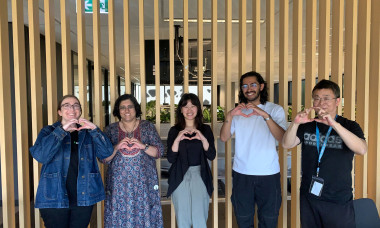Ecosystems and the business of open relationships
I was fortunate to start my company in my early twenties - it’s a time in life when everything feels open and as a young founder, the world seemed full of possibilities. Back then, our team believed we were innovating at the speed of light (write the code, release the code, rinse and repeat), we were bringing on new customers and the business was growing rapidly. What we were building initially would later become a market leader in employment services technology in Australia. I loved that time and how it felt as though we were making our dent in the world.
Fast forward twenty years and ReadyTech is now a public company and a long way from those early days of bootstrapping and hustle. One thing that I’ve never lost is that curiosity of my youth. I still value openness as a core business principle. It’s how I hope we’ve built our company culture. And that also translates to how we think about our place in the wider world - we stay open and always keen to develop our network of new relationships. That same spirit of embracing the art of the possible is central to the idea of an open and connected ecosystem.
Ecosystems
The technology we build is central to how people live, learn and work - effectively how they participate in, and contribute to, their communities. At the core of what we do is mission-critical ops and administration. Our customers use our products to manage complexity, often in highly regulated spaces such as education, payroll, or local government. Given our place as the system-of-record, we enjoy a privileged position in the ecosystem - we become a long-term, trusted partner for customers. In the ecosystem we are effectively a platform, one which other technology solutions can connect with, where we can access their innovation and they can access our customer relationships, resulting in new value creation and a sum greater than the parts.
What we want to avoid is becoming a monolith. You know the software - usually promoted as ‘one platform to rule it all’. That’s the risk we run being so proximate to our customers who routinely ask us to extend our technology to meet their emerging business needs. I’m not 100% sure my younger self would have had the restraint to say no, but we’re in a different age now where SaaS rules and integration presents new ways to solve problems. These days we are more disciplined and apply deep focus on where we can add the most value. Often that’s not more from us directly and the answer can be sourced in the technology ecosystem.
One-stop-shops are convenient, but limited
There is an innate appeal with the idea of having one system. On the surface, it simplifies buying and managing technology. One vendor, one contract – ‘one throat to choke’. However, in the sectors where we operate, it’s also impossible. The complexity demands that any business, and that includes even our smallest customers, will always use more than one system. So, this idea of a monolithic ERP system that tries to do everything is rapidly being challenged and seen as a thing of the past.
So, what next?
Instead, an ecosystem is built on a philosophical foundation of open integration. Rather than a ‘closed’ system – which looks to capture customers within a single product and solve as many problems as possible, ecosystems acknowledge the value of best-of-breed systems and seek to bring that together to deliver superior customer outcomes. They provide flexibility and choice.
Businesses in turn aren’t locked into lengthy contracts and are able to scale and pivot at speed if needed. The pace of business change is faster than ever so technology velocity is a valuable commodity. These organisations benefit from working with the best of the best. Better still, if one area isn’t performing well or needs scaling, it can be done at any time with limited disruption. This allays a key customer concern - having to replace everything all at once in a ‘big bang’ project. The benefits of an open ecosystem mean that you can change one piece at a time when the timing is right.
Ecosystems in Education
One recent example for ReadyTech is in our education business. A global pandemic was the catalyst for a long overdue technology revolution, reimagining how learning was designed, delivered and consumed. As educators scrambled to stand up online learning, cloud and integration became critical. The most common question we got throughout 2020 was ‘do you integrate with…?’. Thankfully, we’d been building our products with that in mind well ahead of this demand.
A case in point is our work with UNSW College supporting its ambitious plan to digitally transform and provide the best service possible for its students. This undertaking involved substantial resources, both in terms of effort and cost. UNSW College has selected ReadyTech, and by extension, its open ecosystem to empower them to stay ahead of the curve and ensure the future resilience of their technological decisions.
I firmly believe that we are hitting the bottom end of the curve when it comes to innovation with these large-scale ERPs. Our customers can’t take advantage of innovation if they are in a walled garden. Supporting an ecosystem approach invites our tech community to share their brilliance with our customers and as Australia looks to build an exciting start-up community, more companies are hoping to solve niche problems with laser-like focus using the most modern technology. Gen AI, anyone? That places businesses with legacy systems on notice and at risk of being outgunned.
At ReadyTech, our mission is to help communities thrive and when ecosystems work well, they reflect the best of us, the best of our communities.






